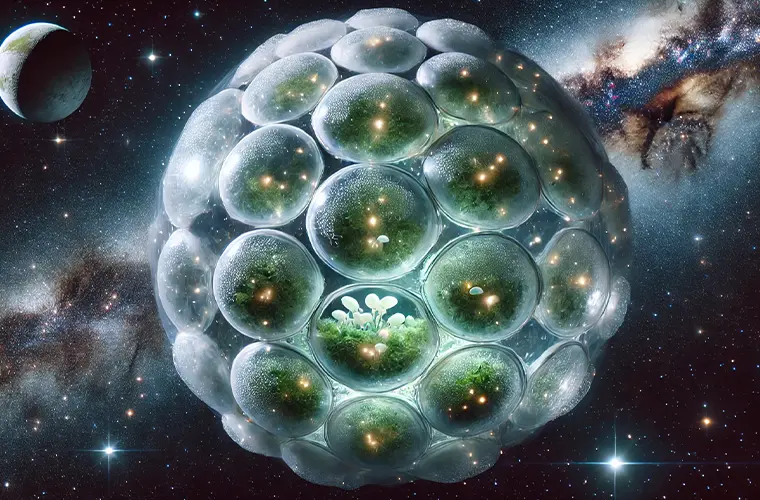A study by researchers from Harvard and the University of Edinburgh challenges traditional views of extraterrestrial habitability, suggesting self-sustaining habitats could allow alien life to survive and even thrive without a terrestrial planet to call home under the right conditions.
This new perspective goes beyond the idea of locating life on Earth-like planets and proposes self-sustaining habitats capable of supporting life on smaller celestial bodies or even free-floating in space.
“Standard definitions of habitability assume that life requires the presence of planetary gravity wells to stabilize liquid water and regulate surface temperature,” researchers write. “[However,] Because the evolution of life elsewhere may have followed very different pathways from on Earth, living habitats could also exist outside traditional habitable environments around other stars, where they would have unusual but potentially detectable biosignatures.”
In the search for extraterrestrial intelligence (SETI), astrobiologists have largely focused on Earth-like environments as prerequisites for life. This approach makes sense: Earth is our only proven model for life-sustaining conditions, with its moderate temperatures, liquid water, and stable atmospheric composition.
However, Dr. Robin Wordsworth of Harvard University and Dr. Charles S. Cockell of the University of Edinburgh argue that this focus has left unexplored possibilities for life in environments that don’t resemble our own.
In a preprint paper accepted for publication in the journal Astrobiology, researchers challenge conventional assumptions about extraterrestrial life and explore the feasibility of life existing in structures created by living organisms themselves.
As researchers suggest, life-supporting conditions created solely by biological structures could indeed exist, making it entirely possible for some forms of life to thrive in space habitats vastly different from those on Earth.
“Most astrobiology research over the past few decades has focused on increasing our understanding of life’s diversity and evolution on Earth and searching for Earth-like environments (past or present) in the solar system and beyond,” researchers wrote. “One obvious yet often neglected fact in this debate is that we already have direct evidence of life existing beyond Earth, in the form of human space missions.”
“However, humans are simply a particularly complex form of life, so it is interesting to consider how much complexity is really needed for life to sustain itself beyond Earth.”
Dr. Wordsworth and Dr. Cockell outline how certain biological structures could overcome the hostile conditions in space, including temperature extremes, pressure vacuums, radiation, and the lack of essential nutrients.
Key to this vision is the idea of “living habitats”—ecosystems that support life internally and regulate conditions for their own survival. These structures could resemble biopolymers or biogenic habitats that allow light to enter while blocking harmful ultraviolet rays and retaining volatile gasses like water vapor.
For example, silica aerogels—synthetic, lightweight materials with exceptional insulating properties—can raise internal temperatures by as much as 50 degrees, enough to sustain liquid water in freezing conditions.
While silica aerogels are currently industrially produced, researchers point out that biogenic materials with similar properties already exist. Diatoms, a type of algae, naturally produce silica shells on a nanoscopic scale, showcasing a biological pathway to highly efficient insulation in cold environments.
One of the biggest challenges for life outside planetary atmospheres is maintaining stable pressure and temperature to keep water in liquid form—a necessity for most known life forms.
The study suggests that biologically generated barriers could maintain internal pressures around 10 kPa, which is sufficient for simple organisms. This feat is relatively common in nature; for instance, seaweed can withstand similar internal pressures from oxygen buildup.
Additionally, creating a greenhouse effect using solid-state insulation, like silica aerogels or other materials, could help retain heat within these habitats. Through a concept known as the “solid-state greenhouse effect,” visible light enters the habitat, is absorbed, and then re-emitted as thermal radiation, helping to maintain temperatures suitable for life.
Researchers note that such habitats could potentially maintain stable temperatures between 1 to 5 astronomical units (AU) from the Sun, making them viable across a range of orbital distances and solar exposures.
Radiation, especially ultraviolet (UV) and cosmic rays is another significant threat to life in space. However, researchers detail how natural silica structures or bioplastics could shield these habitats from harmful radiation, allowing only visible light essential for photosynthesis to penetrate.
In fact, Earth’s own microbial life provides insight into how this could work: cyanobacteria and some algae thrive under low-light conditions and can grow even in environments with minimal sunlight, such as under Arctic ice.
Dr. Wordsworth and Dr. Cockell argue that extraterrestrial habitats could use similar mechanisms to harness light efficiently, converting it into energy while blocking harmful radiation. This could be a viable survival strategy, especially for photosynthetic organisms, which could form the base of a self-sustaining ecosystem.
Space is also a constant drain on resources, particularly volatile elements like water and carbon dioxide. While a habitat’s walls might retain some gasses, long-term volatile retention is essential for sustaining life.
According to researchers, walls made of certain biological materials can reduce the escape of volatile compounds. A one-centimeter-thick habitat wall made of biogenic material could retain essential gasses for thousands of years, offering the timescale required for evolutionary processes and ecosystem stability.
Maintenance and growth are also critical for a habitat that must repair itself in the face of micrometeorites, cosmic radiation, and degradation over time. The research suggests that biologically self-repairing habitats are within reach, with microbial communities that could recycle wall material or create new sections.
In nature, bioplastics such as those made from algae and bacteria already offer similar properties, suggesting that space-based ecosystems could rely on these materials to maintain their integrity.
The study’s particularly intriguing question is whether life could evolve to create such self-sustaining habitats without human intervention.
While Earth’s life forms have adapted to extreme conditions, none have naturally created habitats capable of surviving in the vacuum of space. However, the researchers argue that environments around certain stars—such as red dwarfs, where atmospheric erosion is common—could drive evolutionary pressures to develop protective barriers, potentially setting the stage for life forms that build their own habitats.
Although this concept is speculative, it offers exciting possibilities for future research. It could even alter our approach to detecting extraterrestrial life. If biogenic habitats are self-sustaining and produce biosignatures—gases or materials indicative of life—they could be detected remotely, much like the “red edge” effect of chlorophyll detected in Earth’s vegetation from space.
The idea of self-sustaining, biogenic habitats has significant implications beyond astrobiology. These habitats could inform future technologies for sustaining human life beyond Earth, eliminating the need for constant resupply from Earth.
“Most frequently proposed for Mars, terraforming is defined as global modification of the climate via industrial technology in order to create conditions suitable for Earth-like life. It is controversial and would be phenomenally resource-intensive, as it involves global, irreversible modification of an entire planet,” researchers wrote. “In contrast, biologically generated habitats would pose no more of an environmental concern than any human mission.”
“Given the effectiveness of biological systems at recycling waste materials, adaptive biology may offer the most sustainable and environmentally sound way to support the long-term presence of humans and other complex life beyond Earth in the future.”
The ability to create habitats that regulate their conditions using biological processes would mark a monumental step toward sustainable space exploration, with profound implications for our future as a spacefaring species.
Dr. Wordsworth and Dr. Cockell’s novel approach also shifts the focus of the search for extraterrestrial life. Instead of looking solely for planets with Earth-like conditions, astrobiologists could expand their search to include potential biosignatures from these biologically generated habitats.
Future telescopes might look for specific markers of photosynthetic activity, such as a red edge effect or unusual gasses like methane, that could signify life-supporting structures outside a planetary gravity well.
Ultimately, the possibility of life beyond Earth may be much broader than we’ve imagined. Recently, scientists uncovered thriving ecosystems beneath the subseafloor of deep-hydrothermal vents, expanding previous assumptions about life in seemingly inhospitable environments.
By breaking free from the constraints of Earth-like habitability, researchers believe it could open a new chapter in the search for alien life, one where biology adapts to survive even in the most inhospitable corners of space.
Tim McMillan is a retired law enforcement executive, investigative reporter and co-founder of The Debrief. His writing typically focuses on defense, national security, the Intelligence Community and topics related to psychology. You can follow Tim on Twitter: @LtTimMcMillan. Tim can be reached by email: tim@thedebrief.org or through encrypted email: LtTimMcMillan@protonmail.com

